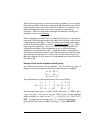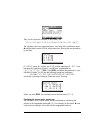
Page 11-36
Now we are ready to start the Gauss-Jordan elimination with full pivoting. We
will need to keep track of the permutation matrix by hand, so take your
notebook and write the P matrix shown above.
First, we check the pivot a
11
. We notice that the element with the largest
absolute value in the first row and first column is the value of a
31
= 8. Since we
want this number to be the pivot, then we exchange rows 1 and 3, by using:
1#3L @RSWP. The augmented matrix and the permutation matrix
now are:
Checking the pivot at position (1,1) we now find that 16 is a better pivot than
8, thus, we perform a column swap as follows: 1#2‚N @@OK@@
@RSWP. The augmented matrix and the permutation matrix now are:
Now we have the largest possible value in position (1,1), i.e., we performed
full pivoting at (1,1). Next, we proceed to divide by the pivot:
16Y1L @RCI@ . The permutation matrix does not change, but the
augmented matrix is now:
The next step is to eliminate the 2 from position (3,2) by using:
2\#1#3@RCIJ
8 16 -1 41 001
2 0 3 -1 010
1 2 3 2 100
16 8 -1 41 001
0 2 3 -1 100
2 1 3 2 010
1 1/2 -1/16 41/16
001
02 3 -1
100
21 3 2
010
1 1/2 -1/16 41/16
00 1
02 3 -1
10 0
0025/8-25/8
01 0


















